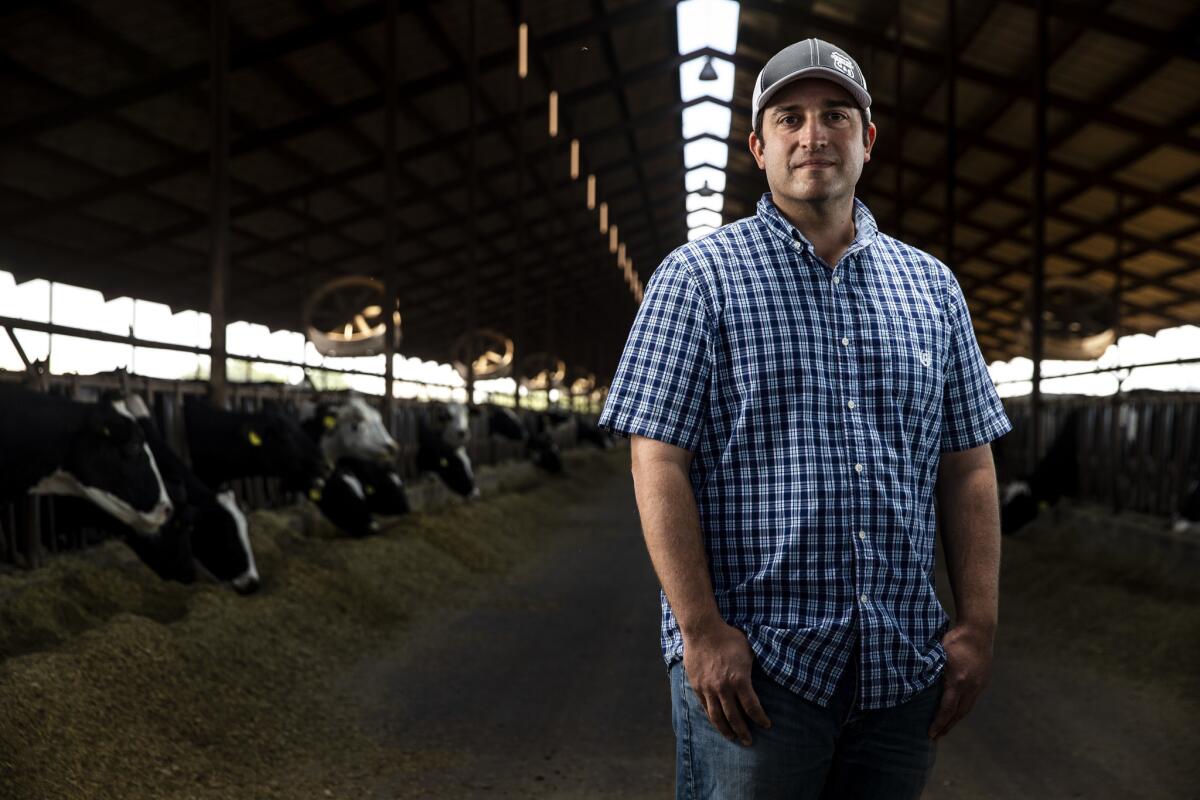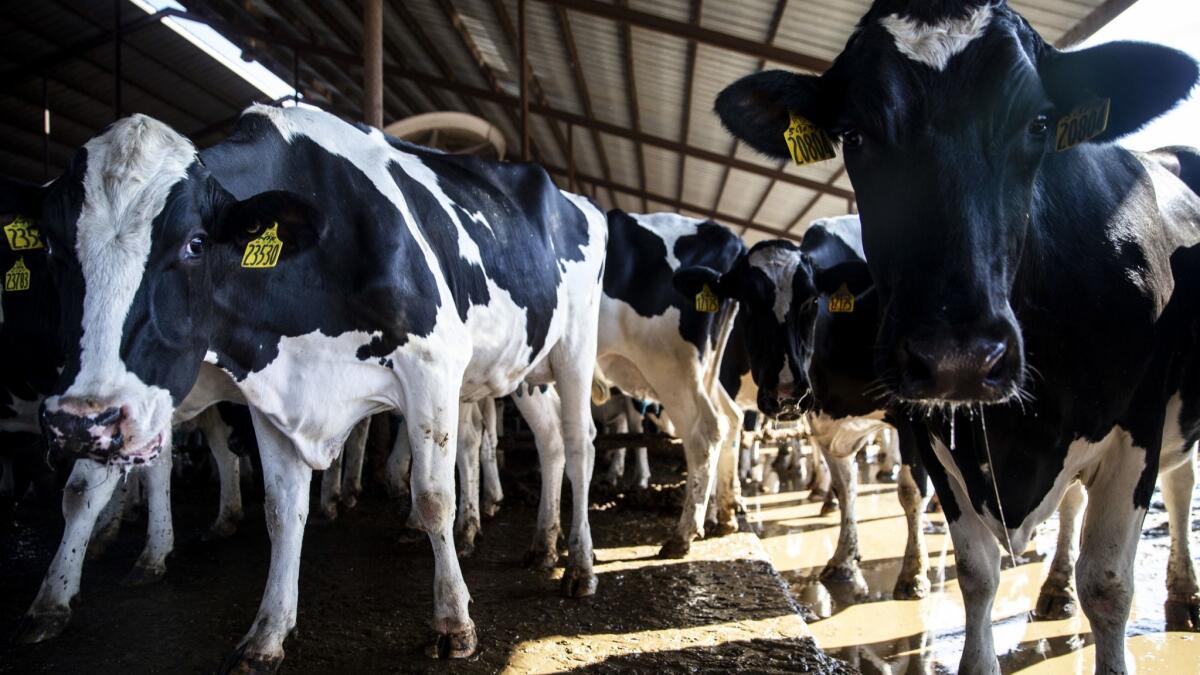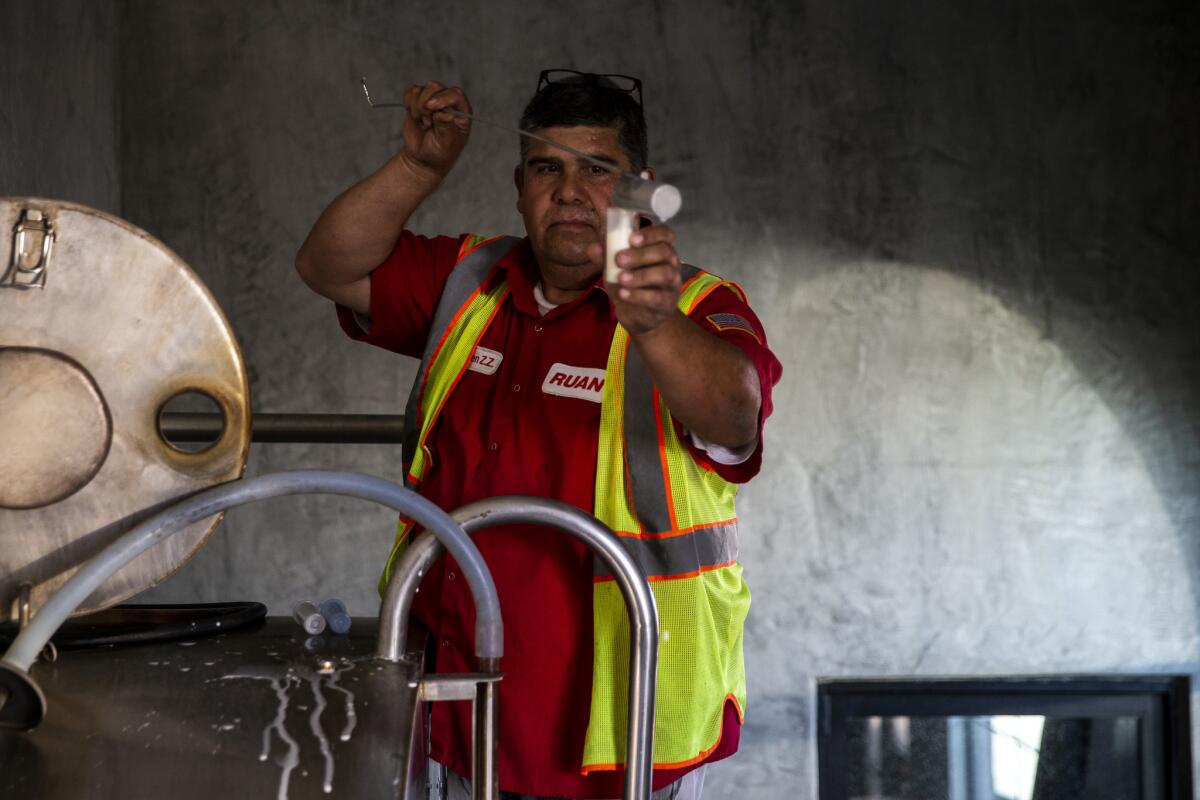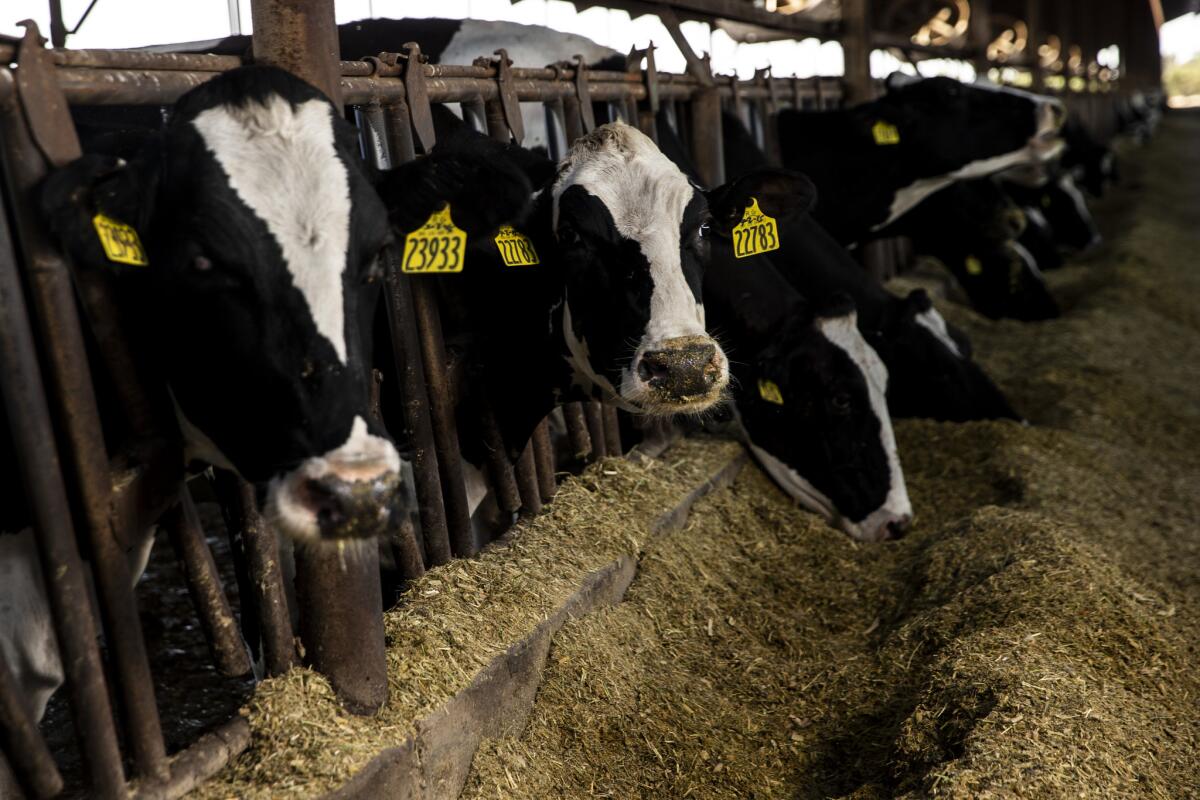Column: California’s dairy farmers were struggling to regain profitability. Then came the trade wars

- Share via
Reporting from Turlock — “The overall feeling is that we hit ‘peak cow’ five or six years ago.”
Devin Gioletti, a fourth-generation dairy farmer in this Central Valley community, was outlining for me the trajectory of the dairy industry in California, the nation’s largest. He was alluding back to when the industry was still growing and milk prices were rising, and his family farm was expanding the herd and investing in advanced equipment to raise the productivity of its thousands of cows.
Things look different now. The industry, including his farm, has been unprofitable since 2014, when prices peaked. Since then, the average producer price for raw milk has fallen by almost one-third, to less than the cost of production.
For a few months this spring, it looked as if milk prices were finally turning around. Then came the tariffs.
Starting at the beginning of July, Mexico and China imposed tariffs on U.S. dairy products in retaliation for Trump administration trade belligerence. China, which had been developing as a promising new market for U.S. dairies, imposed new tariffs on dairy products almost across the board as Trump moved to place 25% tariffs on up to $50 billion in imported goods; combined with existing tariffs, the levies now reach as high as 45% on some products. Trump added 10% tariffs on an additional $200 billion in Chinese imports in August, with a threat to raise them to 25% on Jan. 1.
Meanwhile, Mexico, retaliating for Trump tariffs aimed at forcing a renegotiation of the North American Free Trade Agreement, imposed 25% tariffs on U.S. cheese. Although the agreement has been modestly renegotiated, the tariffs are still in place.

Those moves have left dairy producers feeling like collateral damage in a war they had nothing to do with. Wisconsin may bill itself as “America’s Dairyland,” but California is the leading dairy state in the union, with the most cows and highest production. California dairies had made great strides in opening new foreign markets, in part by exploiting the benefits of NAFTA and by focused approaches to China and other Asian markets.
“Two decades ago, this industry was largely domestic,” says Rachel Kaldor, executive director of the Dairy Institute of California, a statewide trade association. Now, with a third of its production exported to trading partners that are “exercised about tariffs being thrown on their products and want to retaliate, we look like we’re going to be vulnerable,” she says.
“These are markets we’ve been working on for years,” says Annie AcMoody, chief economist for the trade group Western United Dairymen. Dairy producers fear that while they’re shut out of the markets, competitors from Europe, Australia and New Zealand will take the opportunity to strengthen their foothold. “Once you lose a market, it takes time to get it back,” she says.
This column is one of a series on the conflicts between California and the Trump administration. Feel free to send comments or ideas to [email protected].
For Gioletti and other members of California Dairies Inc., the state’s largest dairy cooperative and the second-largest in the U.S., the trade war with China has had a direct effect: “We no longer sell any products into China since the middle of this year,” says Rob Vandenheuvel, the co-op’s vice president of industry and member relations. That means the loss of 6% to 9% of its sales of milk powder. “We’re down to zero there.”

The Trump administration hasn’t paid much attention. The White House announced a plan this summer to provide up to $12 billion in relief for all farmers affected by the tariffs, but only $4.7 billion has been set for payments thus far, including a mere $127 million for dairy farmers nationwide. “That’s a nice symbolic sympathy payment,” Kaldor said, “but it won’t do much to restore markets that have been lost.” Nor will it do much to cover the estimated $1.5 billion in losses the nationwide dairy industry expects to incur this year because the tariffs have pushed dairy prices down.
Agriculture faces untold challenges all over the state, but dairy farmers arguably have a tougher time of it. Livestock has to be cared for more intensively than field crops. On top of the environmental restrictions confronting all farmers, dairies must deal with regulations governing methane, a greenhouse gas produced by cow digestion and bubbling up from the manure spread into pits to be dried for fertilizer. New state rules will regulate how much groundwater farmers can extract, posing another potential limitation on their business.
Labor has gotten scarce. Even though Gioletti’s workforce is mostly foreign-born, it’s not immigration enforcement that’s causing the scarcity, he says, but demand from a surging construction sector that’s outbidding him. (He says he pays an average of $12 an hour, which doesn’t include benefits such as health coverage but does include free housing.)
Then there’s the price of farmland, which has been driven higher by encroaching residential development in Southern California and the suitability of land now devoted to dairies in the Central Valley and Northern California for high-value crops such as almonds. That’s prompted scores of dairies to convert to tree crops in recent years. The number of California dairies has shrunk to 1,331 at the end of 2017 from nearly 1,600 as recently as 2012. Expectations are that by the end of this year the number will fall below 1,300.

But when California dairy owners get together, prices are the No. 1 topic of discussion, Gioletti told me from behind the wheel of his black truck as we tooled around his 800-acre spread (an additional 1,200 acres nearby are farmed for feed). We passed tin-roofed enclosures for his 2,300 Holstein milk cows and for 3,000 heifers (young cows that have not yet calved and thus aren’t yet producing milk), and rows of stalls for calves. At one end of the farm supplies of silage were stored in rows of white plastic sleeves resembling immense, fat caterpillars.
The math of milk prices tells the story of dairy profit and loss in grisly detail. Producer prices are basically derived from a blend of commodity prices on the Chicago exchange for butter, milk powder, cheese and whey. That makes all producers subject to price changes in any of the components.
That’s been a problem for Gioletti and other members of California Dairies Inc. Mexico’s retaliatory tariffs are imposed chiefly on cheese, which the co-op doesn’t produce. But with the value of the cheese component of the overall commodity price being driven down, even non-cheese producers have been feeling the pain.
About 60% of the co-op’s main product, milk powder, is exported, chiefly to Mexico, Vandenheuvel says. Even though the volume of co-op shipments into Mexico hasn’t been affected by the tariffs, he says, “because cheese has been heavily impacted by the tariffs, that’s depressed the farmer’s overall price.”
Prices paid to California dairy farmers averaged $16.50 per 100 pounds in 2017, but were lower at the beginning of this year. They started to creep up during the spring. “Every producer got really enthusiastic,” AcMoody says. But as the National Milk Producers Federation told Agriculture Secretary Sonny Perdue last week, “This optimism was dashed when relations with several major trading partners were first disrupted in late May.”
Prices slumped during the summer as retaliatory tariffs were imposed, falling as low as $13.89 per 100 pounds in July. Since then they’ve crept back up, reaching $15.04 this month. But AcMoody thinks that’s probably about as high as they will get. The cost of production for California dairies averages $17 per 100 pounds. That deficit, obviously, can’t be made up with volume.
The best solution is to become more efficient. That’s the approach taken at Robert Gioletti & Sons. Devin’s great-grandfather started the dairy in the 1920s; his grandfather had 10 cows and 10 heifers, and by the time the farm was taken over by his father and mother, the herd was 500. It’s now run largely by Devin, 37, and his brother Justin, 43. A few months ago they obtained approval from the state to expand to 3,500 cows, which will take six or seven years.
Most consumers probably can’t imagine the degree of mechanization of the dairy farm today. At the Gioletti farm, the Holsteins are herded for milking onto a giant carousel that can hold 72 at a time, hindquarters facing out. The contraption cost the farm $2 million in 2009, but it allows 400 cows to be milked per hour by a staff of four in a sort of industrial ballet, attaching suction devices to the udders, detaching them after the cows are milked and cleaning them for the next cow.
Each of the 2,300 cows is milked three times a day to produce 90 pounds of milk. Before the installation, the farm was milking 1,800 cows twice a day, yielding about 75 pounds each.
The economics of dairy farming have Gioletti and his brother pondering whether to hand the farm off to the next generation, though that transition is years away, since the oldest of their children is only 12. “We have to think about whether we want to pass debt on to the next generation,” he said.
Gioletti already has planted almonds on some of his acreage, though he hasn’t abandoned dairy farming to do so like some other Central Valley farmers. Prices are linked not merely to the international trade situation, but also to consumer habits. Dairy farmers are gratified that butter consumption in the U.S. is rising to levels not seen in half a century, driven by “foodie” tastes and a declining health reputation for substitutes such as margarine. A strong general economy prompts people to eat out more, which correlates with more dairy consumption.
Of course, an economic slump could reverse those trends too. For California farmers, the future still beckons from overseas, which means that the trade war is the key. “We’re hoping this will work itself out in six months to a year,” Gioletti told me. But that could be a crucial six months during which buyers could be lost, possibly forever.
Keep up to date with Michael Hiltzik. Follow @hiltzikm on Twitter, see his Facebook page, or email [email protected].
Return to Michael Hiltzik’s blog.
More to Read
Inside the business of entertainment
The Wide Shot brings you news, analysis and insights on everything from streaming wars to production — and what it all means for the future.
You may occasionally receive promotional content from the Los Angeles Times.











